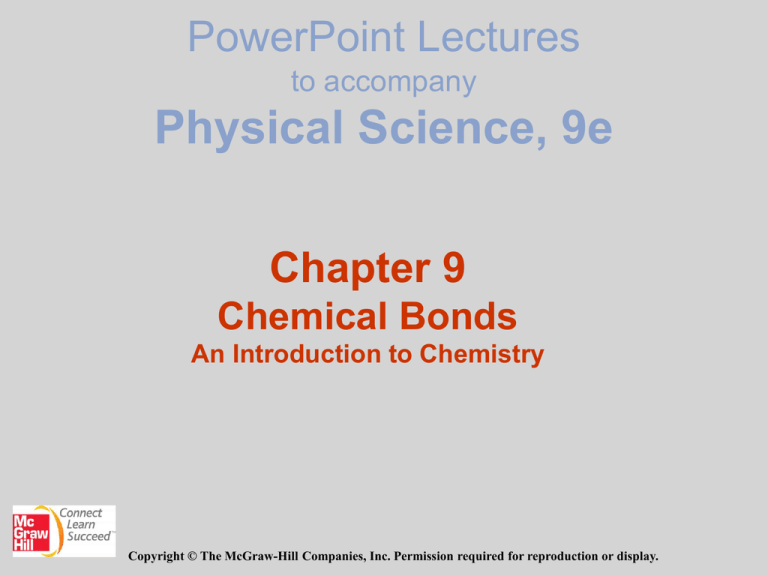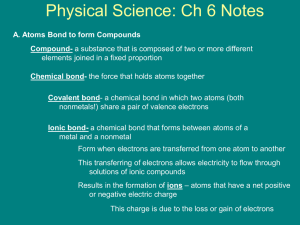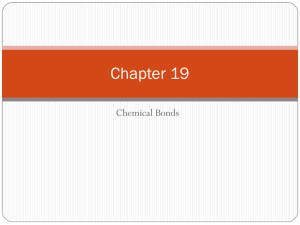Chemical bonds
advertisement

PowerPoint Lectures to accompany Physical Science, 9e Chapter 9 Chemical Bonds An Introduction to Chemistry Copyright © The McGraw-Hill Companies, Inc. Permission required for reproduction or display. Core Concept Electron structure will explain how and why atoms join together in certain numbers. Compounds and Chemical Change • Atom - smallest elemental unit • Molecule – smallest particle still retaining the characteristic chemical properties of a substance – Examples: • oxygen, hydrogen gas diatomic molecules • Ozone - triatomic oxygen molecule • Noble gases: helium, neon - “monatomic” molecules Chemical Reactions • Formation and/or breaking of chemical bonds to form new molecules (products) from old ones (reactants) • Chemical energy internal bonding potential energy • Chemical equation symbolic summary of chemical reaction Valence Electrons and Ions • Outer electrons determining the chemical properties of an atom • Octet rule – Atoms attempt to acquire an outer shell of eight electrons – Electrons can be gained/lost/shared in the process • Example: sodium (Na) Chemical Bonds • Attractive forces holding atoms together in compounds • Can be described in terms of molecular (delocalized) or atomic (localized) orbitals • Covalent Three types: • Ionic • Metallic bonds – Electrons transferred between atoms – Electrostatic force = binding force – Octets achieved through sharing electrons – Typically between nonmetallic elements, r.h.s of periodic table – Outer electrons move freely throughout metal – “Electron gas” within rigid lattice of metal atoms – Conduct heat and electricity well Ionic Bonds • Chemical bond of electrostatic attraction • Form crystalline solids with orderly geometric structure • Example: NaCl • Na loses; Cl gains • No single NaCl molecule, per se Energy and Electrons in Ionic Bonding • Reaction energy released = heat of formation • Divided conceptually into half-reactions Electron transfer rules • Electrons lost/gained to form closed octets • Number gained = number lost Ionic Compounds and Formulas Formulas • • List elements in compound and their proportions Proportions decided by electron gain/loss Ionic compounds • • • • Characterized by ionic bonds White, crystalline solids soluble in water Families IA and IIA lose electrons and form positive ions Families VIA and VIIA gain electrons to form negative ions Covalent Bonds • Chemical bonds formed by sharing pairs of electrons • Electrons shared to form octets, ideally • Overlap of shared electron clouds between nuclei yields net attraction • Atoms within covalent compounds are electrically neutral, or nearly so Covalent Compounds and Formulas • Covalent compound held together by covalent bonds • Electrons shared in covalent bonds • Electron dot representation – Bonding pairs shared – Lone (non-bonding) pairs not shared Multiple Bonds • Sharing of more than one electron pair • Examples – Ethylene - double bond – Acetylene - triple bond Bond Polarity • Result of unequal sharing of electrons • Electronegativity – Measure of an atom’s ability to attract electrons – Differences: • 1.7 or greater - ionic • 0.5-1.7 - polar covalent • Less than 0.5 - covalent Electronegativities Composition of Compounds • Millions of different combinations of over 90 elements • Common names – Often related to historical usage (baking soda, washing soda,…) – Difficult to relate to actual molecular composition • Modern approach - systematic sets of rules – Different for ionic and covalent compounds – One common rule - “-ide” means compound contains only two different elements Ionic Compound Names • Name of metal (positive) ion first; then nonmetal (negative) ion • Many elements have variable charges • Historical suffix usage – “-ic” for higher of two; – “-ous” for lower • Modern approach – English name of metal followed by Roman numeral indicating charge Ionic Compound Formulas • Two rules – Write symbol for positive ion first followed by negative ion symbol – Assign subscripts to assure compound is electrically neutral • Example: Calcium chloride Covalent Compound Names • Molecular composed of two or more nonmetals • Same elements can combine to form a number of different compounds Two rules • First element in formula named first with number indicated by Greek prefix • Stem name of second element next; Greek prefix for number; ending in “-ide” (for two elements) Covalent Compound Formulas • Examples: carbon dioxide, carbon tetrachloride • Valence – Number of covalent bonds an atom can form – Hydrogen valence = 1 – Oxygen = 2; single and double bonds – Nitrogen = 3; single, double and triple bonds – Carbon = 4 - single, double and triple bonds








